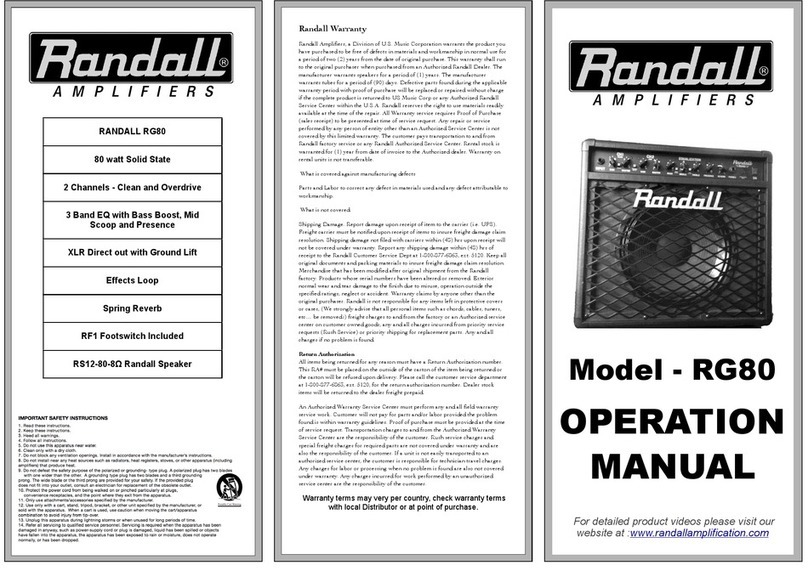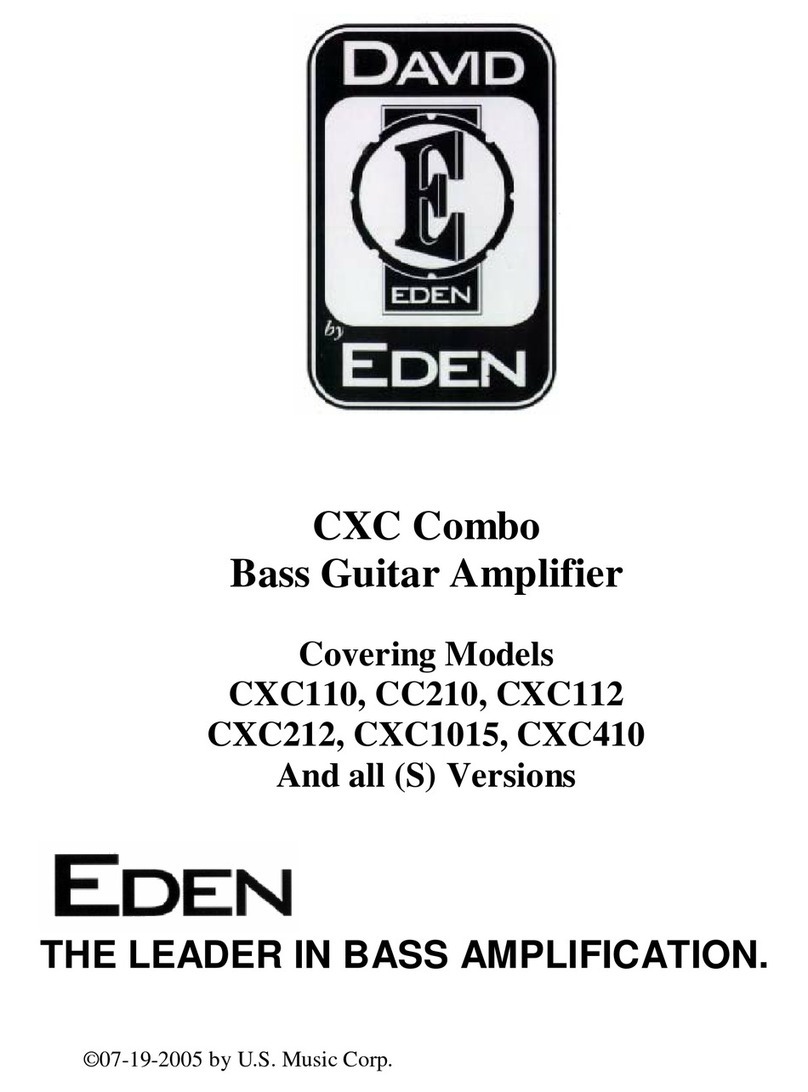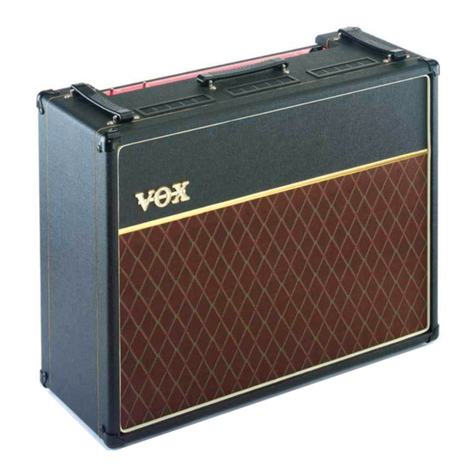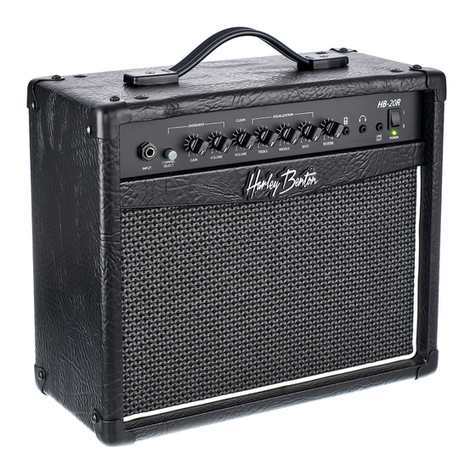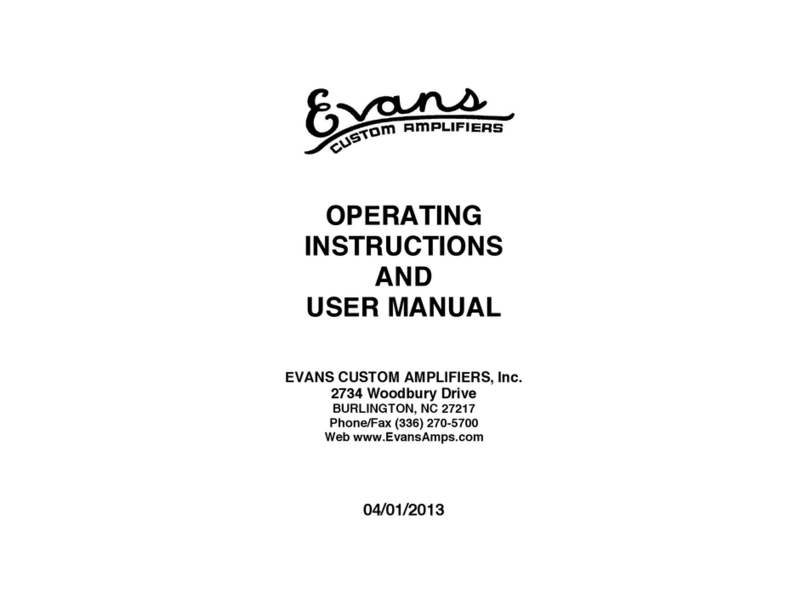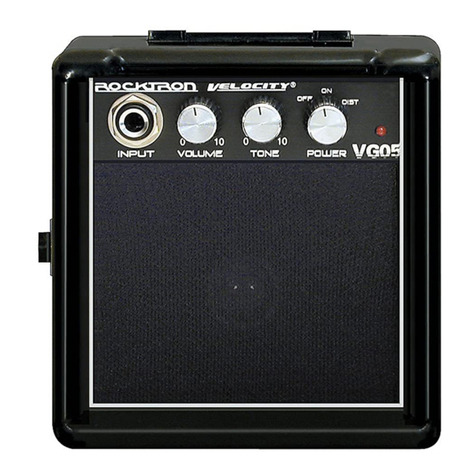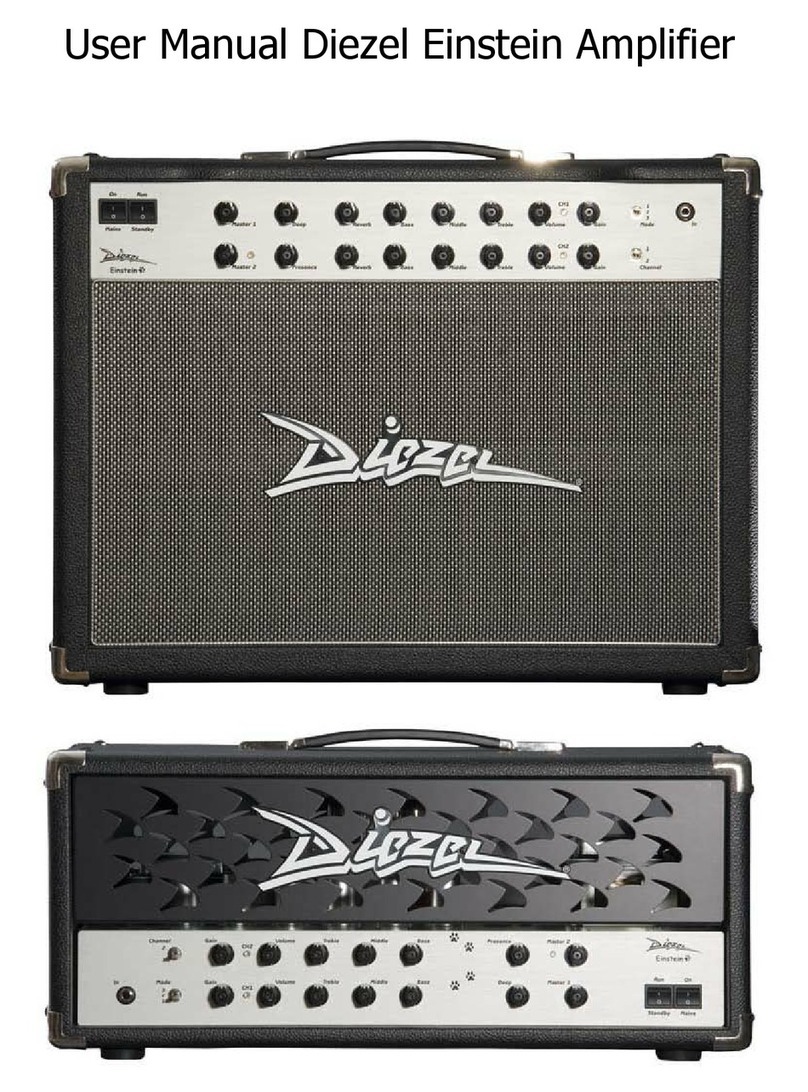HEVOS 400D User manual

Owner’s manual
400D
bassamplifier
USA/Canada

Contents
Safety instructions page 3
Introduction page 4
Directions for use page 6
Control panel page 7
Technical features page 9
Product warranty
and service page 10
2

Safety instructions
1. This amplifier is supplied with ~115V. Connect the
amplifier exclusively to a power point with earth
connection. Never open the amplifier. Repairs are
exclusively done by Hevos and by companies that have
been authorized by Hevos. Otherwise the warranty will
become void.
2. The amplifier should not be used outdoors. Avoid
exceptionally warm places, places that are dusty or dirty
and places of high humidity .
3. If the power cable is damaged, the amplifier has been
dropped or the amplifier is not working correctly
immediately switch off the amplifier and disconnect it
from the power point. The amplifier should be repaired
by an authorized company only.
4. Never pull out the plug by the cable.
5. For cleaning, only use a dry soft cloth. Never use any
water or chemicals.
6. In case of illicit or wrong use, wrong connection, wrong
control or repair by a non-authorized company or
person the warranty will become void as well.
7. Whenever you want to dispose of the amplifier, hand it
in at your local recycling company.
3

Introduction
The HEVOS 400D is a hybrid bass amp (tube/MOSFET)
with class-D power amp. The pre-amp has the advantages
that come with the use of a tube: a high dynamic range and
a good sound. The class-D power amp is a linear amplifier,
designed for high end purposes.
The tone control unit is a 5-band type and is very easy to
use. The frequencies are 60, 250, 800, 2500 and 8000 Hz ,
+/- 12 dB. The amplifier has been built in such a way that
in normal acoustic circumstances there will be no need to
use the tone control. But musicians sometimes have to play
in acoustically bad places, and only then do you need the
tone control to correct the frequency specter.
The tube is fed with DC current to avoid the noise that is so
typical for many tube amps. The anode current has a built-
in delay to assure a longer life for the tubes. The power
amp is protected against short circuit, clipping and DC at
the output. The power supply transformer has a thermal
protection. The clip led near the power switch turns red if
there is a clipping risk. If real clipping or DC at the output
occurs, the amplifier turns off automatically. Switch off the
amplifier for several minutes to reset the protection.
The input of the pre-amp consists of a passive and an
active bass input, which are switchable, making it possible
to switch from one bass to the other without any
connecting problems.
4

There is a gain control to each input, changing the led color
into red if the input signal is too high. If necessary,
decrease the signal by means of the volume knob at the
bass or at the amplifier. Next to the input there is a Mute
Out to tune your bass without disturbing your fellow
musicians or the audience.
At the back there is a symmetric line-out with ground-lift
switch and pre/post switch. Pre means that your ‘clean’
bass signal is sent to a mixing panel, without any influence
of the volume knob or tone control or effect loop at the
amplifier. Post means that the signal sent can be influenced
by the setup of the pre amp.
The effect loop is mixable with the clean bass signal.
Turning the mix knob clockwise mixes the clean signal
with the effect signal from 0 to about 50%, depending on
the signal range of the external effect. With a foot switch it
is possible to turn on/off the effect loop.
The power amplifier is a class-D type with UcD
techniques. Thanks to these advanced techniques the 400D
has some unique features. The amplifier produces hardly
any heat, so a fan or cooling block are absent. Moreover,
this power amplifier has an extreme low distortion and
noise figures and is very stable.
5

Installation directions for use
1. Connect the amplifier exclusively to a power-point
with earth pin.
2. When you switch on the amplifier, there is a delay of
30 seconds. As soon as the red led (17) turns green the
amplifier is ready to be used.
3. When you connect or disconnect your bass, take care
of the Volume knob is put to 0 or use the Mute-knob
to avoid switch clicks.
4. If the led (15) at the input turns red often, the input
signal is too large. Decrease the input signal by
turning the volume knob at the amplifier or bass.
5. If the green led (17) near the power switch turns red,
there is a risk of clipping. Decrease the volume with
volume knob (7) or master knob (13).
6. If clipping or DC at the output occurs led (17) turns
red continuously. Turn off the amplifier to reset the
clip protection.
7. Under normal acoustical circumstances there is no
need to use the tone controls. However, if one should
use the tone controls, it is advised to do so carefully.
Each tone control goes up to +12/-12 dB. The
sensitivity increases while turning the knob clockwise
and anticlockwise.
8. Do not switch on the amplifier if no loudspeakers are
connected. The minimal total impedance of the
connected loudspeaker(s) is 2 Ohms.
9. Only use loudspeaker cables of excellent quality.
6

Control panel
1.Active input: for bass guitar with active tone control and
double bass with active tone control. Sensibility: 6 mV eff.
2.Passive input: for passive bass guitar and double bass
without active tone control. Sensibility: 3 mV eff.
3.Mute out: connector for tuning gear.
4.Headphone: switches off loudspeaker
5.Mute switch: switches the signal to your tuning gear and
cuts the internal signal.
6.Active-Passive switch: switches between active and
passive input.
7.Volume: controls the signal amplitude to the pre-amp.
8.Low: tone control 60 Hz, ± 12 dB, Q = 0,5
9.Low-Mid: tone control 250 Hz, ± 12 dB, Q = 0,5
10.Mid: tone control 800 Hz, ± 12 dB, Q = 0,5
11.Mid-High: tone control 2500 Hz, ± 12 dB, Q = 0,5
12.High: tone control 8000 Hz, ± 12 dB, Q = 0,5
13.Master: controls the signal amplitude to the power amp.
14.On-off switch: switch for power supply.
15.Input led: turns red when input signal is too high
16.Mute led: turns red when mute is active
17.On-off led: turns green after 30 seconds when switching
on the amplifier. Turns red when power amp clips. At
permanent clipping and DC on the output the amplifier
switches off. Switch off the power for several minutes to
reset the clip protection.
7

18. Power connector: 115V/50-60 Hz. With built-in fuse
and spare fuse.
19. Groundlift switch: cuts the earth between amplifier and
PA/mixing console if necessary.
20. Mix: mix control for effect loop. Mixes the amplifier
signal continuously with the signal of an external effect
processor.
21. Footswitch: to switch the effect processor on/off.
22. Return: input for signal from external effect processor.
Automatically switches off the internal signal. The internal
signal can be mixed with the effect signal.
23. Send: output to external effect processor. Also
asymmetrical line out to external power amp. (1 V eff.).
24. Pre/post switch: taps the line out signal from pre-
Volume or from post-Tone Control and Effect Loop
25. Line-out: symmetrical XLR-output to PA/mixing
console. Signal comes from output of first tube but is pre-
volume and -tone control.
26. Speaker 1
27. Speaker 2: both outputs are connected parallel to each
other. Minimal impedance 2 Ohms. So connecting 2
loudspeakers of each 4 Ohms = 2 Ohms totally.
8

Technical features
Type: tube pre-amp, MOSFET class-D power amp
Height: 1 U
Weight: 8,5 kgs
Power: 400 Watts / 4Ω, 550 Watts / 2 Ω
Distortion: < 0,1% THD at 400 Watts
Damping: > 2000 at 100 Hz in 4 Ohms
Tube: 12AX7 (1x)
Input: 1 passive, 1 active , switchable
Tone control: active, 5 band: 60, 250, 800, 2500 and 8000
Hz +/-12 dB
Protection against: short circuit, DC current at output,
mismatch and open end; clip indicator; thermal protection
power supply transformer; delayed power switch; clip
indicator at the input.
Divers: mute out; mixable effect loop with foot switch;
symmetric line-out with pre/post switch; headphone
output; ground lift; DC tension filament tube.
Output: 2x Speakon , symmetric line-out, mute out,
send-return, foot switch, headphone
Components: dust proof pot meters, Neutrik connectors
9

Product warranty and service
This product is guaranteed against defects of used materials and
operation from the moment of purchase during a period of 2 years. If
during this warranty period this product does not function properly,
Hevos will fit the product to the use it is intended for without passing on
the costs of labour and materials to the purchaser under the following
strict conditions:
Conditions:
1. The obligation of Hevos is restricted to the repair or replacement of
defects. Hevos is at liberty to decide whether it should be repair or
replacement. Transport costs are at the purchaser’s expense. Hevos
cannot be held responsible for any kind of risk during transport
(e.g. loss, damage etc).
2. All repairs under warranty should be done by Hevos or a company
that has been authorized by Hevos. Repairs by non-authorized
companies are no part of this warranty. If the product is damaged
due to non-authorized repairs then this warranty will become void.
3. This warranty applies only for defects of used materials and
operation. The warranty does not apply for:
damage caused by lightning, induction, faulty power supplies,
faulty power cords, insufficient ventilation, flooding, fire, smoke,
peace disturbances hooliganism and war.
damage caused by accidents, negligence, modifications and
wrong use or wrong installation or wrong transport
products with illegible serial numbers or numbers that have
been tampered with
4. The warranty expires when the product is hired, lent or sold to third
parties.
5. Specifications and information contained in this manual are
furnished for informational use only, and are subject to change at
any time without notice and should not be construed as a
commitment by Hevos. Hevos assumes no responsibility or
liability for any errors inaccuracies that may appear in this manual.
10
Table of contents
Popular Musical Instrument Amplifier manuals by other brands

Fischer Amps
Fischer Amps Guitar Amplifier operating instructions

Acoustic
Acoustic AG60 user manual
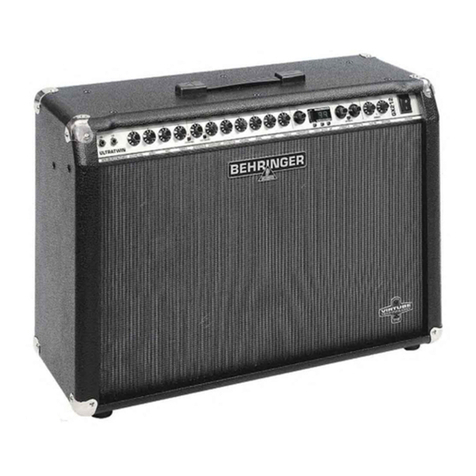
Behringer
Behringer Ultratwin GX212 user manual
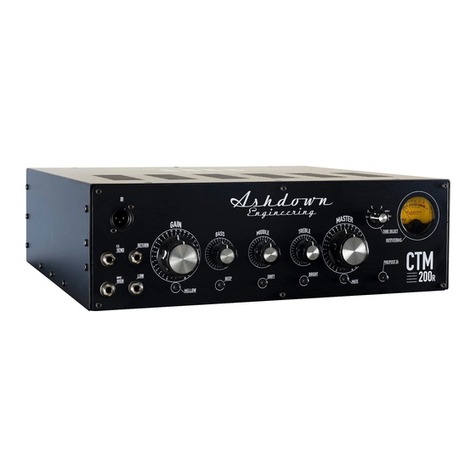
Ashdown
Ashdown CTM-200-RACK user manual

Mesa/Boogie
Mesa/Boogie Three Channel Dual & Triple Rectifier Solo... owner's manual
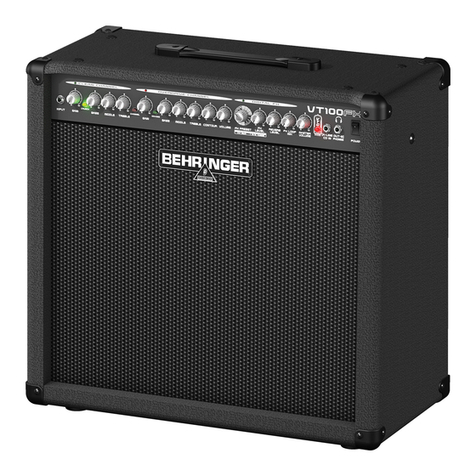
Behringer
Behringer VIRTUBE VT100FX user manual
